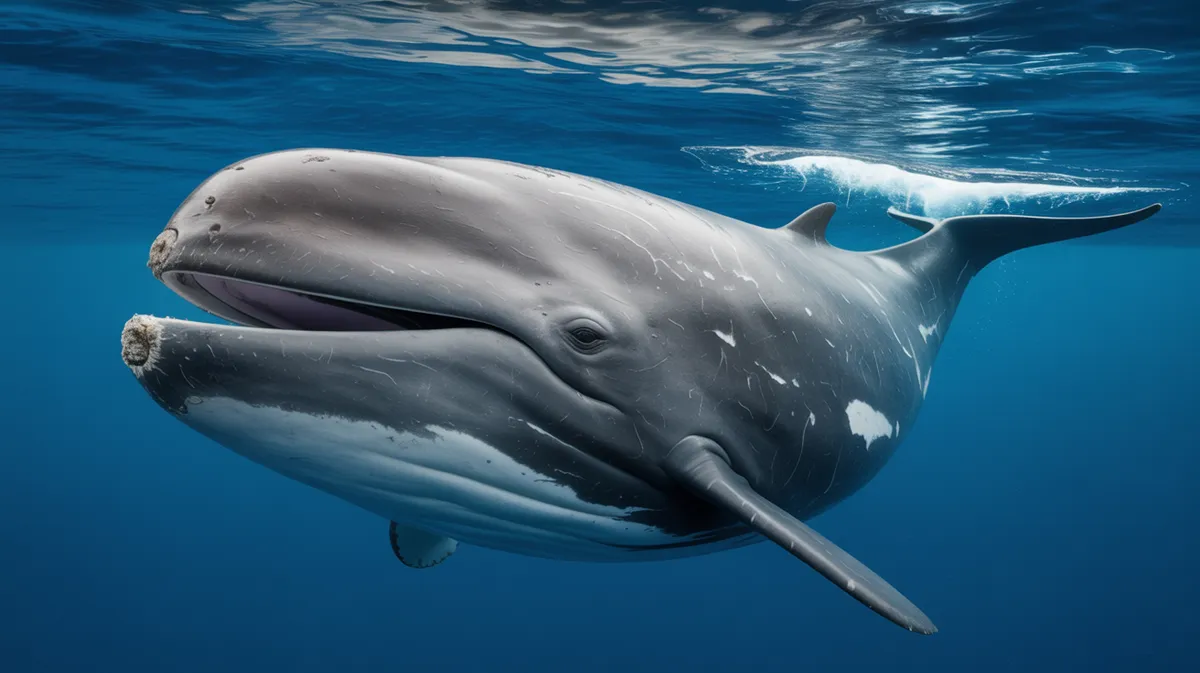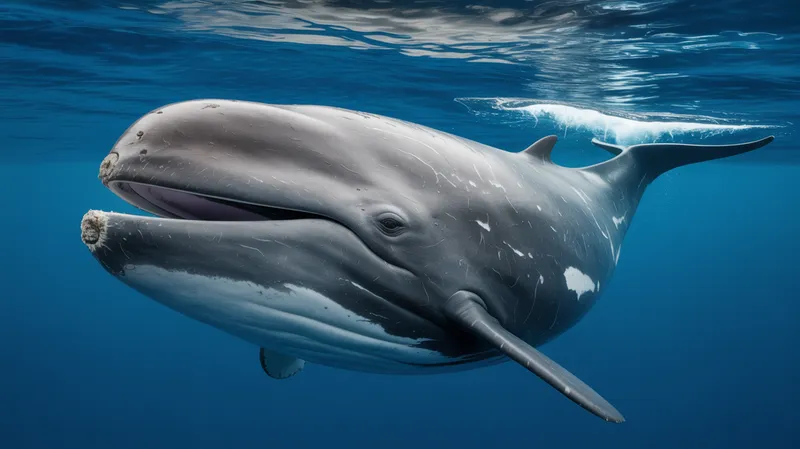
Cuvier's Beaked Whale
Ziphius cavirostris

Meet the Cuvier's Beaked Whale
Cuvier's Beaked Whale is a medium-sized cetacean known for its robust body, short beak, and unique sloping forehead. It is the most widely distributed beaked whale species, inhabiting deep offshore waters of most world oceans. These elusive whales are rarely seen at the surface and are exceptionally adapted to deep-diving, often hunting squid and fish at remarkable depths. Males can be recognized by two prominent teeth at the tip of the lower jaw and by extensive body scarring from intraspecific conflicts. Despite their elusive nature, Cuvier's Beaked Whales have been the subject of deep-diving studies due to their record-breaking dives.
Classification
Mammal
Habitat
Deep offshore oceanic waters
Diet
Carnivore
Lifespan
30-60 years
Conservation
Least Concern
Weight
2,000–3,000 kg
📖Fascinating Facts
Exceptional Divers
Cuvier's Beaked Whales are the deepest-diving mammals, capable of diving nearly 3,000 meters and holding their breath for up to 222 minutes.
Visible Male Teeth
Adult males have a pair of protruding tusk-like teeth at the tip of their lower jaw, which are used in fights for dominance.
Global Distribution
This species is found in deep waters of all major oceans, from the tropics to cool temperate seas.
📋Detailed Description
Cuvier's beaked whale (Ziphius cavirostris) is a robust, medium-sized cetacean, typically measuring 5.0–7.0 meters in length and weighing between 2,000 and 3,000 kilograms. The species is characterized by a short, poorly defined beak, a gently sloping melon, and a small, falcate dorsal fin set far back on the body. Adults display a variable coloration, ranging from dark gray or brown to reddish-brown, often with extensive white scarring, especially in males. These scars are primarily caused by intraspecific competition and interactions with cookiecutter sharks. The species exhibits pronounced sexual dimorphism: males possess a pair of forward-pointing, erupted teeth at the tip of the lower jaw, which are used in combat for mating rights. Cuvier's beaked whales are deep-diving specialists, capable of reaching depths nearing 3,000 meters and remaining submerged for over 3.5 hours—records among all mammals. Their bodies are streamlined for efficient movement through the water column, and their lungs and circulatory systems are highly adapted to withstand the pressures and hypoxic conditions of the deep sea. Socially, they are usually found in small groups of 2–7 individuals, though solitary animals and larger aggregations have been observed. Their elusive nature and preference for deep, offshore habitats make them challenging to study, but they are among the most frequently sighted beaked whales at the surface. Reproduction is poorly understood, but calving is believed to occur year-round in some regions, with a likely gestation period of around 12 months. Their global distribution spans all major oceans except polar regions, making them the most cosmopolitan of the beaked whales.
💡 Did you know?
Despite being rarely seen, Cuvier's Beaked Whale is the most widely distributed beaked whale in the world.
🔬Research & Sources
Wikipedia Summary
Cuvier's beaked whale, goose-beaked whale, or ziphius is the most widely distributed of all beaked whales in the family Ziphiidae. It is smaller than most baleen whales—and indeed the larger toothed cetaceans —yet it is large among the beaked whales and smaller cetaceans, appearing somewhat like a bigger and stockier bottlenose dolphin. Cuvier's beaked whale is pelagic, generally inhabiting waters deeper than 300 m (1,000 ft), though it has been observed closer to shore on occasion. In these offshore waters, Cuvier's beaked whales execute some of the deepest and longest recorded dives among whales, and extant mammals. The current published records are 2,992 m (9,816 ft) for dive depth and 222 minutes for dive duration as recorded by biologging instruments attached to individual whales. While likely diving to forage and hunt prey, such as cephalopods, and potentially evade predators, the frequency and exact reason for these extraordinary dives is unclear. Despite its deepwater habitat, it is one of the most frequently-spotted beaked whales when surfacing.
Last Modified: 5/25/2025
🎭Behavior & Social Structure
Cuvier's beaked whales are predominantly deep-water, pelagic animals, spending the majority of their lives at depths exceeding 1,000 meters. They exhibit a strong preference for steep continental slopes, submarine canyons, and oceanic trenches, where prey is abundant. Their daily routine is dominated by long, deep foraging dives interspersed with shorter, shallow recovery dives near the surface. Foraging behavior involves echolocation to locate prey, primarily deep-sea squid, but also fish and crustaceans. Social interactions are generally limited to small, stable groups, often comprising females and their offspring, while adult males may be more solitary or accompany groups temporarily. Surface behavior is discreet; they rarely breach or display acrobatics, typically surfacing quietly for a series of short breaths before diving again. Vocalizations are primarily ultrasonic clicks used for echolocation and possibly communication, but little is known about their social calls. Scarring patterns suggest frequent aggressive encounters among males, likely related to competition for mates.
👶Reproduction & Life Cycle
Reproductive biology in Cuvier's beaked whales is not fully documented due to their elusive habits. Mating systems are presumed to be polygynous, with males competing for access to females, as evidenced by the extensive scarring from tusk-like teeth. Females likely reach sexual maturity at around 7–11 years of age, while males mature slightly later. Gestation is estimated to last approximately 12 months, with calves born at about 2.7 meters in length and weighing around 250 kilograms. Calving may occur throughout the year, though some evidence suggests regional peaks. Neonates are nursed for at least one year, during which time they remain closely associated with their mothers. Interbirth intervals are thought to be two to three years. Parental care is provided exclusively by the mother, with no evidence of paternal involvement.
🛡️Adaptations & Survival
Cuvier's beaked whale exhibits a suite of remarkable adaptations for deep diving and life in the mesopelagic and bathypelagic zones. Physiologically, they possess highly collapsible lungs and flexible rib cages, allowing them to withstand immense hydrostatic pressures. Their blood and muscle tissues are rich in myoglobin and hemoglobin, enabling efficient oxygen storage and delivery during prolonged dives. They can reduce their heart rate (bradycardia) and shunt blood away from non-essential organs to conserve oxygen. Behaviorally, their echolocation clicks are adapted for detecting prey in the pitch-black depths, and their streamlined bodies minimize drag. The thickened, reinforced lower jaw and erupted teeth in males are evolutionary specializations for intraspecific combat. Their ability to minimize surface time and silent surfacing behavior may help avoid predators such as killer whales.
📚Research Sources
🎨Cultural Significance
Cuvier's beaked whale has limited direct cultural significance due to its elusive behavior and deep-water habitat. However, its striking appearance and mysterious habits have inspired curiosity and myth in maritime cultures. The genus name 'Ziphius' derives from the Greek for 'swordfish,' reflecting its beak-like snout, and the species was historically misidentified as a sea monster in early natural history. In some Mediterranean regions, strandings have contributed to local folklore. The species is occasionally referenced in scientific literature and conservation campaigns as a symbol of the hidden biodiversity of the deep ocean.
🔬Recent Research & Discoveries
Recent research on Cuvier's beaked whales has focused on their extreme diving physiology, acoustic ecology, and responses to anthropogenic noise. Biologging studies using satellite tags and time-depth recorders have revealed record-breaking dive depths and durations, providing insights into mammalian adaptations to hypoxia and pressure. Acoustic monitoring has improved understanding of their vocal behavior and distribution, especially in deep-sea canyons. Notably, studies have linked naval sonar exposure to atypical mass strandings, prompting international regulatory efforts. Genetic analyses indicate low population structure globally, suggesting high dispersal capacity. Ongoing research aims to clarify population sizes, reproductive rates, and the long-term impacts of ocean noise and climate change.
🎥Wildlife Videos

Divina Guadalupe Beaked Whale Research Project
If you cannot see the captions on this video, just click on CC on the lower right corner of video settings on the video ** #Breaking ...
Sea Shepherd

🦈 Incredible Whale Encounters Caught On Camera II All about species and creature on Earth.
Celebrating nature, science, space and the human race, BBC Earth brings you face to face with heart-pounding action, ...
BBC Worth

😳 This Is What Biggest Whale In The World LOOK LIKE🫣 II All about species and creature on Earth.
Celebrating nature, science, space and the human race, BBC Earth brings you face to face with heart-pounding action, ...
BBC Worth

World Of Animals#:Marine life
Most marine species live in the euphotic zone (surface layer) down to depths of 200 m/650 ft. However, some dive deeper in ...
Africa nature

💤🦈 SURPRISE Scary Whale Encounters You Shouldn't Watch 🤯II All about species and creature on Earth.
Celebrating nature, science, space and the human race, BBC Earth brings you face to face with heart-pounding action, ...
BBC Worth

😳😱 WHALE ENCOUNTER UNDERWATER II All about species and creature on Earth.
Celebrating nature, science, space and the human race, BBC Earth brings you face to face with heart-pounding action, ...
BBC Worth
🌍Habitat Information
The Cuvier's Beaked Whale typically inhabits Deep offshore oceanic waters environments. Cuvier's Beaked Whales have adapted to their environments with specialized features and behaviors.
Primary Habitat:
Deep offshore oceanic waters
More detailed habitat information will be available soon.
🛡️Conservation Status
The Cuvier's Beaked Whale is currently classified as Least Concern. Conservation efforts are crucial for preserving this species for future generations.
Common Threats:
- 🏠Habitat loss and fragmentation
- 🌡️Climate change impacts
- 🎯Hunting and poaching
- 🏭Human-wildlife conflict
⚠️Threats & Conservation Challenges
Despite being classified as Least Concern by the IUCN, Cuvier's beaked whales face several anthropogenic threats. The most significant is underwater noise pollution, particularly from naval sonar and seismic surveys, which has been linked to mass strandings and decompression sickness-like symptoms. Entanglement in fishing gear, ingestion of marine debris, and ship strikes are additional risks. Climate change may alter prey distribution and deep-water habitats, potentially impacting foraging success. Although direct hunting is rare today, historical whaling and bycatch have occurred in some regions. Population trends are poorly understood due to the species' cryptic nature, but localized declines have been reported in areas with intense naval activity. Conservation challenges include the difficulty of monitoring populations and mitigating the effects of deep-sea noise pollution.
🔬Scientific Classification
Scientific Name
Ziphius cavirostris
Classification Hierarchy
🔍 About Taxonomic Classification
Taxonomic classification is a hierarchical system used by scientists to classify and organize living organisms based on shared characteristics and evolutionary relationships.
The system moves from broad categories (Kingdom) to increasingly specific ones, with each animal's scientific name typically consisting of its Genus and species.
📝Community Notes
Share your observations and insights about the Cuvier's Beaked Whale with our community of wildlife enthusiasts.
Join Our Community
Sign in to share your observations and connect with fellow wildlife enthusiasts.
Sign In to ContributeNo community notes yet
Be the first to share your observations about the Cuvier's Beaked Whale!
Explore Cuvier's Beaked Whale
Select a tab above to learn more about this amazing animal.
📸Photo Gallery
No photos available for this animal yet.
🌟Discover More Wildlife
Continue your journey of discovery with more fascinating animals from our database
